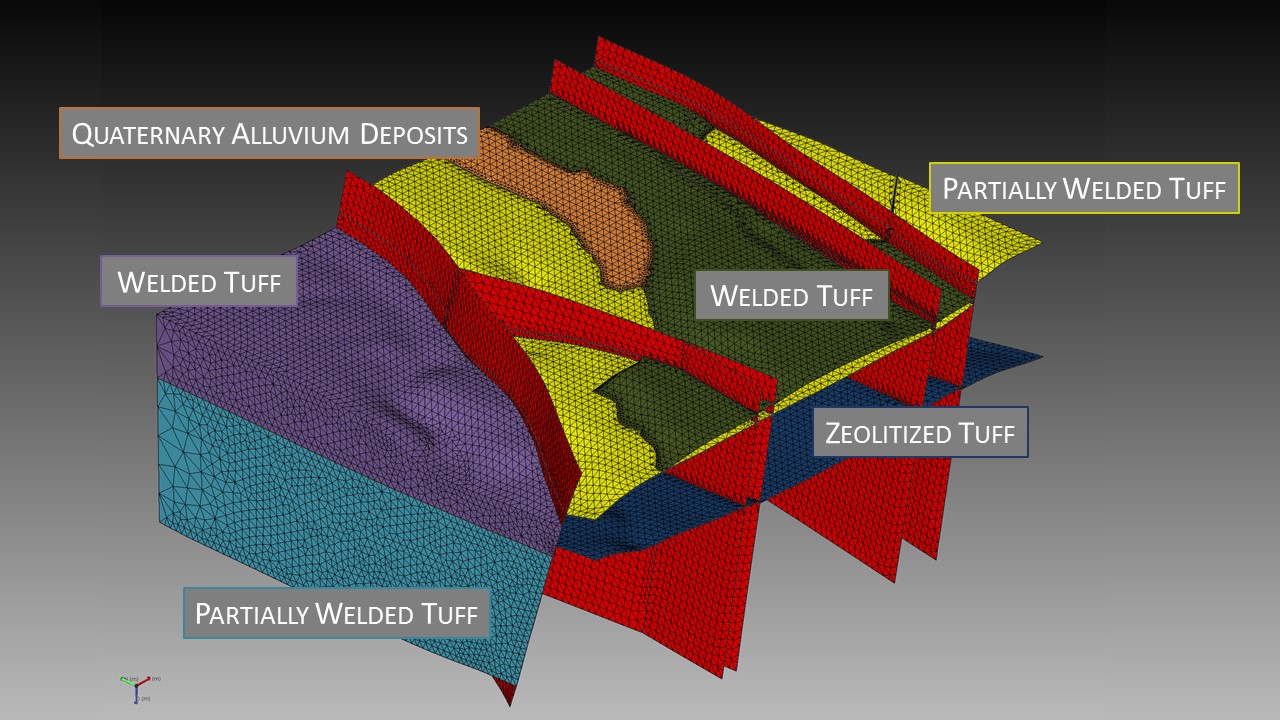Modeling and Simulation

Geologic framework model (GFM) created by EES-14 geologists in collaboration with geologists at other DOE laboratories and contractors. GFMs are an essential product for accurately modeling Earth’s subsurface in a variety of energy and security applications.
The Modeling and Simulation Team
We focus on researching the processes governing the Earth’s response to loading across a full range of strain rates, from quasi-static tectonic forces to loads caused by explosive detonations. We specialize in the development of numerical models to support crustal tectonics, high strain-rate shock propagation, and the dynamics of rock fracture.
Our science
- Explosive effects, ground shock, and structure vulnerability to weapons
- Combined fluid-mechanical fracture
- Multi-scale computational geomechanics and geodynamics
- Constitutive model development
Explosive Effects, Ground Shock, and Structure Vulnerability to Weapons: Using the finite element method, we model explosive source experiments. Our modeling uses an “end-to-end” framework, which includes explicit simulation of the source, propagation of shock through the near field geologic medium, and connection through seismic wave fields to the monitoring regime. Modeling allows both parametric studies and comparison to test data, to discern the complex components of explosive source phenomenology and response of engineered systems to loading. This work supports explosion monitoring, weapon targeting, and facility design.
Combined Fluid-Mechanical Fracture: We apply the finite element and hybrid finite-discrete element methods to study rock fractures. This research includes fractures due to explosives and subsequent gas flow through transient permeability, as well as well-bore fracture and reservoir exploitation via hydraulic fracturing for enhanced and oil and gas recovery.
Constitutive Model Development: Developing new and unique material models for use in numerical simulation of geodynamic phenomena. Improved comprehensive material models:
- Enhance description of wave propagation through pre-damaged or weathered media.
- Required to model accurate deformation of Earth materials, particularly at high strain-rates.
Multi-Scale Computational Geomechanics and Geodynamics: Our analysis methods apply to a full variety of scales from micro- to meso- to macro-scale; that is, from microfractures as identified on thin sections, through laboratory rock core analysis, to full field testing of large-yield explosives, including simulations hypothetical nuclear events.
Constitutive Model Development: Much of the work described above is supported by in-house development of appropriate geomaterial models. Constitutive response of rocks and soils is very complex, particularly under dynamic loading. Moreover, recent developments of hybrid finite/discrete elements as well as fully coupled Eulerian and Lagrangian modeling of near source rock regimes requires development of state-of the-art material models to adequately represent the physics of near-source damage.
|
| LANL Profile Google Scholar |
Chris Bradley - Research Scientist |
 LANL Profile Google Scholar |
Ting Chen - Research Scientist
|
 LANL Profile Google Scholar |
Andrew Delorey - Research Scientist
|
 LANL Profile Google Scholar |
Earl Knight - Research Scientist |
 LANL Profile Google Scholar |
Carene Larmat - Research Scientist
|
 LANL Profile Google Scholar |
Zhou Lei - Research Scientist
|
| LANL Profile Google Scholar |
Bryan Euser - Postdoctoral Researcher |
 LANL Profile Google Scholar |
Ke Gao - Postdoctoral Researcher
|
 LANL Profile Google Scholar |
Viet Tuan Chau - Postdoctoral Researcher
|






